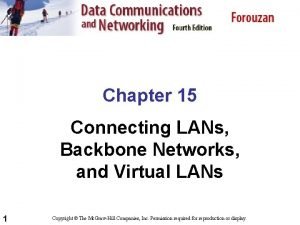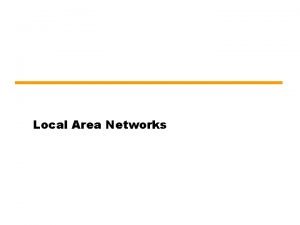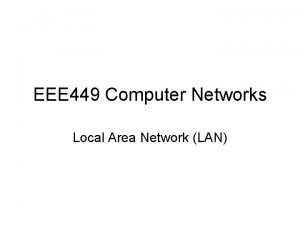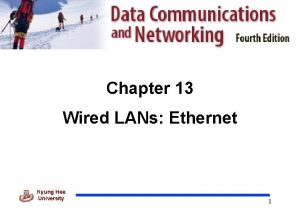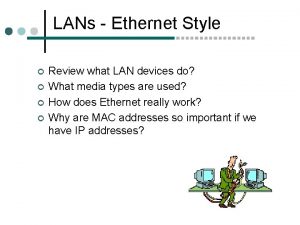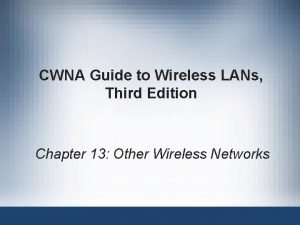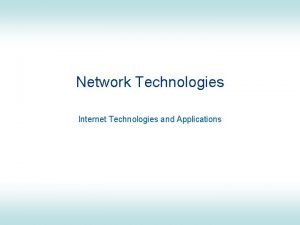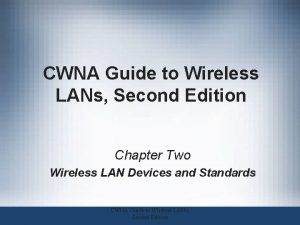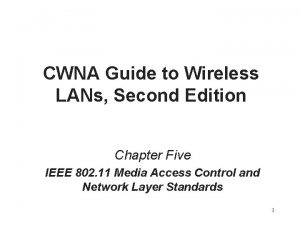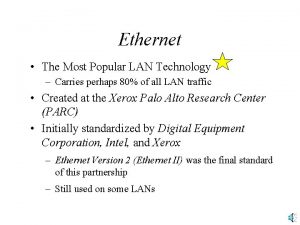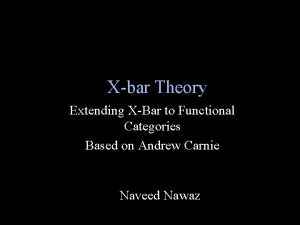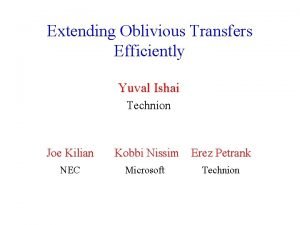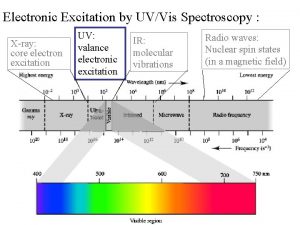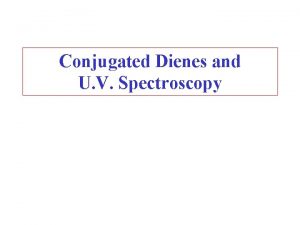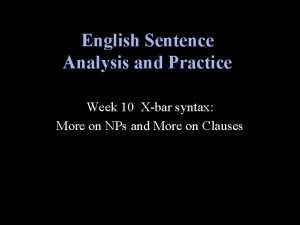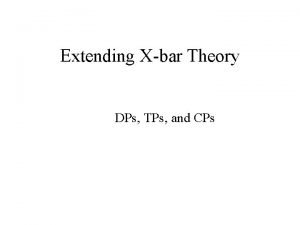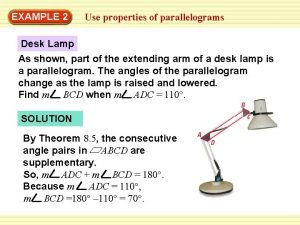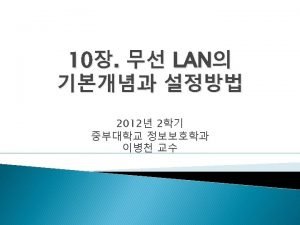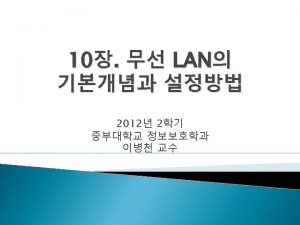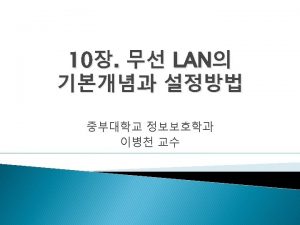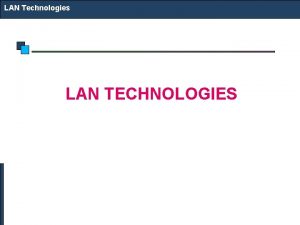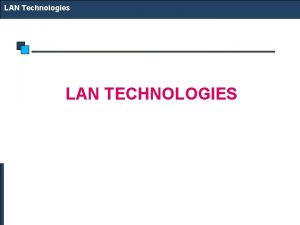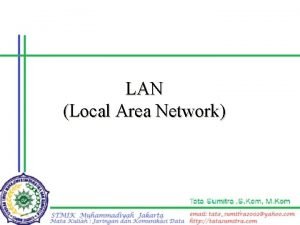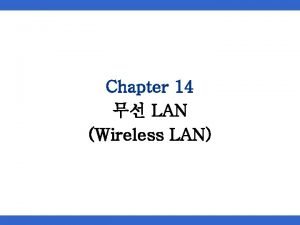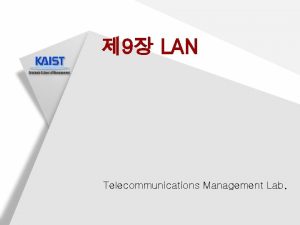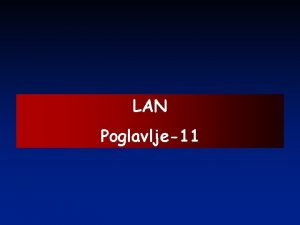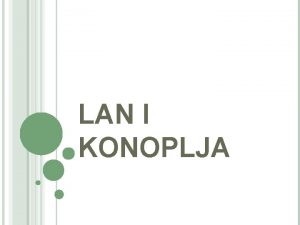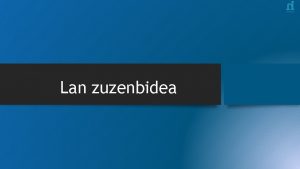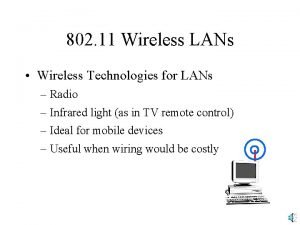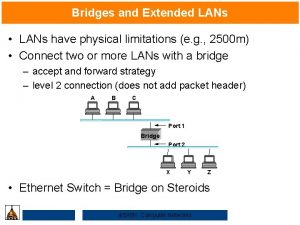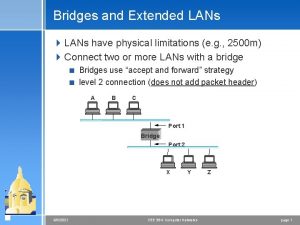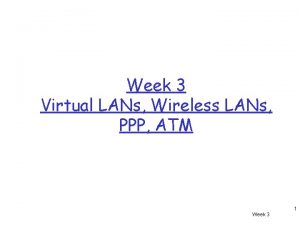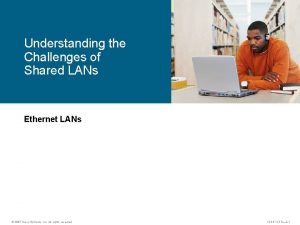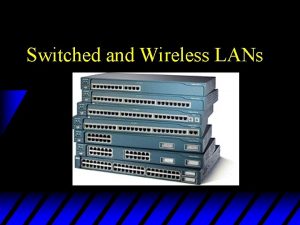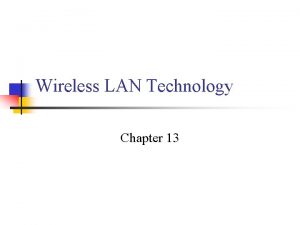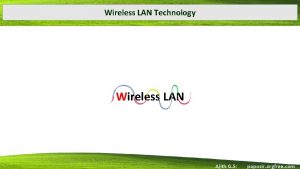Extending LANs 1 Motivation Recall Each LAN technology




























- Slides: 28

Extending LANs 1

Motivation • Recall – Each LAN technology has a distance limitation – Example: CSMA/CD cannot work across arbitrary distance • However – Users desire arbitrary distance connections – Example: two computers across a corporate campus are part of one workgroup 2

Extension Techniques • Must not violate design assumptions • Often part of original design • Example technique – Use connection with lower delay than copper 3

Illustration Of Extension For One Computer • Optical fiber – Has low delay – Has high bandwidth – Can pass signals within specified bounds 4

Repeaters • • Hardware device Connects two LAN segments Copies signal from one segment to the other Connection can be extended with Fiber Optic Intra-Repeater Link 5

Repeaters (Con’t) • Amplifies signals from one segment and sends to the other • Operates in two directions simultaneously • Propagates noise and collisions • Each repeater and segment increase the delay – Limit of four repeaters • Drawbacks: – Do not understand complete frames – Does not distinguish between the signals that correspond to a valid frame and other electrical signals 6

Repeaters And The Original Ethernet Wiring Scheme • Designed for office • Only two repeaters between any pair of stations 7

Hub • Physically – Small electronic device – Has connections for several computers (e. g. , 4 or 20) • Logically – Operates on signals – Propagates each incoming signal to all connections – Similar to connecting segments with repeaters – Does not understand packets • Extremely low cost 8

Bridges • • • Hardware device Connects two LAN segments Forwards frames Does not forward noise or collisions Learns addresses and filters Allows independent transmission 9

Bridge Algorithm • • • Listen in promiscuous mode Watch source address in incoming frames Make list of computers on each segment Only forward if necessary Always forward broadcast/multicast 10

Illustration Of A Bridge 11

Extending A Bridge • Typically optical fiber • Can span buildings 12

Satellite Bridging • Can span arbitrary distance 13

Apparent Problem • Complex bridge connections may not be apparent • Adding one more bridge inadvertently introduces a cycle • Consider a broadcast frame 14

An Example of bridges connected in a cycle 15

Spanning Tree Algorithm • Allows cycles • Used by all bridges to – Discover one another – Break cycle(s) • Known as Distributed Spanning Tree (DST) 16

Spanning Tree Algorithm • Problem: loops • Bridges run a distributed spanning tree algorithm – select which bridges actively forward – developed by Radia Perlman – now IEEE 802. 1 specification 17

Algorithm Overview • Each bridge has unique id (e. g. , B 1, B 2, B 3) • Select bridge with smallest id as root • Select bridge on each LAN closest to root as designated bridge (use id to break ties) • Each bridge forwards frames over each LAN for which it is the designated bridge 18

Algorithm Details • Bridges exchange configuration messages – id for bridge sending the message – id for what the sending bridge believes to be root bridge – distance (hops) from sending bridge to root bridge • Each bridge records current best configuration message for each port • Initially, each bridge believes it is the root 19

Algorithm Detail (cont) • When learn not root, stop generating config messages – in steady state, only root generates configuration messages • When learn not designated bridge, stop forwarding config messages – in steady state, only designated bridges forward config messages • Root continues to periodically send config messages • If any bridge does not receive config message after a period of time, it starts generating config messages claiming to be the root 20

Switch • Electronic device • Physically similar to a hub • Logically similar to a bridge – Operates on packets – Understands addresses – Only forwards when necessary • Permits separate pairs of computers to communicate at the same time • Higher cost than hub 21

Conceptual Switch Function • Conceptual operation – One LAN segment per host – Bridge interconnects each pair of segments • NOT an actual implementation 22

Switched Ethernet A simple example of switched Ethernet. {each plug-in card forms its own collision domain, card to card communication via high speed backplane. } 23

Interconnection Devices • Repeaters – – Understand Volts, do not understand frames, packets, or headers Physical Devices that are connected to two cable segments • Hub – Multiport • Bridges – – Connect two LANs Route on frame addresses (e. g. , Extract 48 -bit destination address in Ethernet) • Switches – – Similar to bridges in that both route on frame addresses Most often used to connect computers • Router – Network Layer Device • Transport Gateway – Connect two computers that use different connection-oriented transport protocols. For example, TCP > connection oriented ATM 24

Interconnection Devices 2 25

Summary • LANs – Have distance limitations – Can be extended • Fiber can be used between computer and LAN • Repeater – Connects two LAN segments – Repeats and amplifies all signals – Forwards noise and collisions 26

Summary (continued) • Bridge – Connects two LAN segments – Understands frames – Uses addresses – Does not forward noise or collisions – Allows simultaneous transmission on segments 27

Summary (continued) • Hub – Central facility in star-shaped network – Operates like a repeater • Switch – Central facility in star-shaped network – Operates like a set of bridged segments 28
 Network that allows several lans to be connected is
Network that allows several lans to be connected is High speed lans
High speed lans Lans
Lans Ethernet evolution through four generations
Ethernet evolution through four generations Lans style
Lans style Cwna guide to wireless lans 3rd edition
Cwna guide to wireless lans 3rd edition Internet technologies and applications
Internet technologies and applications Show that the maximum efficiency of pure aloha is 1/(2e)
Show that the maximum efficiency of pure aloha is 1/(2e) Adam lans
Adam lans Cwna guide to wireless lans
Cwna guide to wireless lans Cwna guide to wireless lans
Cwna guide to wireless lans Four generations of ethernet
Four generations of ethernet Most popular lan technology
Most popular lan technology X bar theory
X bar theory Emerging proficient extending
Emerging proficient extending La=2πrh
La=2πrh Extending oblivious transfers efficiently
Extending oblivious transfers efficiently Extending mendelian genetics
Extending mendelian genetics Spectrum xray
Spectrum xray Uv spectra of dienes
Uv spectra of dienes Holandric genes
Holandric genes Section 1 chromosomes and phenotype study guide a
Section 1 chromosomes and phenotype study guide a A high point of land extending into water
A high point of land extending into water Problem 8-3 extending amounts across the work sheet
Problem 8-3 extending amounts across the work sheet Large land mass
Large land mass X bar theory exercises with answers pdf
X bar theory exercises with answers pdf A pointed piece of land extending into the sea
A pointed piece of land extending into the sea Dps tps
Dps tps Parallelogram lamp
Parallelogram lamp
